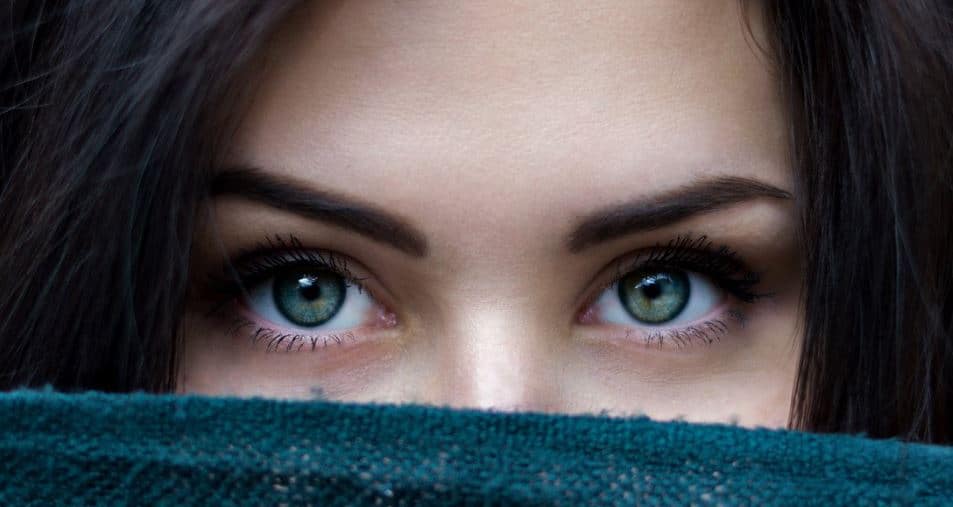We’re doing a lot of eye-reading these days. Eyes and their eyebrows and forehead are all we can see on the face in these days of pandemic. And, as everybody should know by now, that’s a problem for people with hearing loss.
Mask-wearing hides our lower faces, leaving only the eyes to help speechreaders decipher what’s being said. The muffled sounds coming from behind the masks are gibberish to our ears, and so eyes are our only usable facial visual cues.
Because we don’t know the masked person well – or at all – we’re not familiar with their manner of speaking. They might be vibrant and expressive people, or more reserved with no excessive facial expressions. It would be helpful if we knew which. And perhaps here on their job at a retail store or a cafe, their normal expressiveness might be dulled by the stress of dealing with masked customers. They’ve been told that under no circumstance should they lower their mask. I get that, I do. We all want to be safe, but so much has changed.
People with hearing loss who never did well at Halloween parties now have to communicate with masked people on a regular basis. In normal times, before mid-March of 2020, people with hearing loss would use a number of cues to understand speech (or not).
- Residual hearing to understand the spoken word
- Context – knowing the topic being discussed
- (Discreetly) watching the mouth, drawing information from the shape and use of lips, teeth, tongue and jaw.
- Reading the eyes and eyebrows and their interactions:
- Eyes narrowed with brows drawn together could be confusion, or anger, or intense concentration. But now, who knows?
- Eyebrows raised and eyes wide could be surprise, but sometimes people use this combination when they are repeating things very carefully as to a child, or us, the people who are having trouble understanding.
- Eyes crinkled – this often means laughter especially if accompanied by an upward thrust of the chin, appropriate body language, and a muffled, repetitive sound from behind the mask which could be a bwa-ha-ha!
- Eyes shift up to the ceiling or the side – this is not usually a good thing. The person could be losing patience with you, a feeling you probably reciprocate.
- Body language – arms folded across chest means all sorts of things, but usually that the person is closed off from what you’re trying to get from them. If their hands are held out in front of them, palms up, they may explaining something to you, although a grocery store cashier’s hands are usually holding food items so don’t expect much info from body language.
But now, if we must converse with people who can’t or won’t lower their masks, we’re dependent on their eyes or willingness to point at something that is important to what they’re trying to make me understand. Speech-to-text apps are fabulous helpful, but not 100% accurate due to the degradation of sound coming from behind the mask; even hearing people struggle. But they do help, especially if you explain why you’re pointing a phone at their mouth; I suggest being prepared and having the app running by the time you need to converse with whoever is serving you. Fumbling with your phone while being acutely aware of several pairs of eyes watching you, is not a stress-free communication moment.
My grocery store has now switched to large clear shields, rather than having cashiers wear masks. I’m grateful for this. I’m also very grateful for mask-wearers in other situations who, when I tell them I’m dependent on speechreading, lower their mask momentarily, stand back a few feet, and tell me what I need to know. This quickly puts an end to the stressful, back-and-forth dance of miscommunication, and I have a new entry into my Fabulous People list.
 Eyes are beautiful and I love looking at them. I just enjoy them more when I can also see the person’s mouth. For an interesting article on how to decipher a person’s eye behavior, read writer Vanessa Van Edwards’ article on her site, Science of People.)
Eyes are beautiful and I love looking at them. I just enjoy them more when I can also see the person’s mouth. For an interesting article on how to decipher a person’s eye behavior, read writer Vanessa Van Edwards’ article on her site, Science of People.)








Brilliant and funny , but oh so true
Great observations about nuances of eye and head position expressions.
You are such a great writer!!!
Regards,
RK
https://youtu.be/GjqUagWGtmw
Great shield to wear over mask
The Humanity Sheild made by Rapidresponseppe in Juneau Alaska
Very comfortable
Easy to breathe
Visibility 180 degrees